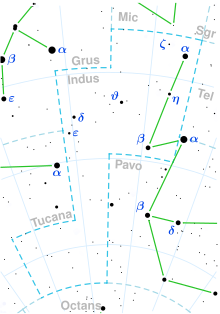
| |
| Observation data Epoch J2000 Equinox J2000 | |
|---|---|
| Constellation | Indus |
| Right ascension | 21 50 0.12 |
| Declination | −64° 42′ 45.1″ |
| Apparent magnitude (V) | 5.6 |
| Characteristics | |
| Evolutionary stage | Horizontal branch |
| Spectral type | K0III |
| B−V color index | 0.99 |
| Astrometry | |
| Radial velocity (Rv) | −0.1701±0.1237 km/s |
| Proper motion (μ) | RA: −0.7032±0.0807 mas/yr Dec.: −37.4432±0.0893 mas/yr |
| Parallax (π) | 9.5919 mas |
| Distance | 343.9±2.6 ly (105.5±0.8 pc) |
| Absolute magnitude (MV) | 0.54 |
| Details | |
| Mass | 2.42±0.27 M☉ |
| Radius | 11.6±1.4 R☉ |
| Luminosity | 74.13+1.12 −1.15 L☉ |
| Surface gravity (log g) | 2.6±0.2 cgs |
| Temperature | 4945±100 K |
| Age | >1 Gyr |
| Other designations | |
| 2MASS J21500013-6442451, FK5 3742, HD 207229, HR 8331, IRAS 21461-6456, PPM 365403, SAO 255080, TIC 406320735, TYC 9119-2234-1 | |
| Database references | |
| SIMBAD | data |
HIP 107773 is a star located 344 light years from Earth in the southern constellation Indus. It is classified as a horizontal branch K-type giant star, having a spectral type K0III and a radius of 11.6 R☉. With an apparent magnitude of 5.6, the star can be faintly seen with the naked eye. It has an exoplanet, HIP 107773 b, a gas giant orbiting it at a distance of 0.72 astronomical units (108,000,000 km), about the same distance from Venus to the Sun.
Characteristics
HIP 107773 is a giant star, having a spectral type K0III, where K0 means it is a K-type star and III (luminosity class) means it is a giant star. The star is in the horizontal branch phase of evolution. HIP 107773 has a radius equivalent to 11.6 solar radii, and a mass equivalent to about 2.4 solar masses. It is cooler than the Sun, having an effective temperature of 4,945 K (4,672 °C). Given the mass and the evolutionary stage of the star, its age is estimated to be at least about one billion years.
Planetary system
HIP 107773 has an exoplanet, HIP 107773 b, discovered in 2015 using the radial velocity method. The planet is classified as a gas giant, having a minimum mass of 2 MJ and an estimated radius of 1.19 RJ. It orbits its star at a distance of 0.72 astronomical units (108,000,000 km), about the same distance as Venus is from the Sun, and completes one orbit every 144 days (0.39 years). Its orbit is almost circular, with an eccentricity of just 0.09.
With a mass of 2.4 M☉, the star HIP 107773 is one of the most massive stars with a close-in planet.
| Companion (in order from star) |
Mass | Semimajor axis (AU) |
Orbital period (days) |
Eccentricity | Inclination | Radius |
|---|---|---|---|---|---|---|
| b | ≥1.98±0.21 MJ | 0.72±0.03 | 144.3±0.5 | 0.09±0.06 | — | 1.19 (estimate) RJ |
See also
Notes and references
- ^ "HIP 107773". SIMBAD. Retrieved January 21, 2024.
- ^ Ginski, C.; Mugrauer, M.; Adam, C.; Vogt, N.; Holstein, R. G. van (2021-05-01). "How many suns are in the sky? A SPHERE multiplicity survey of exoplanet host stars - I. Four new close stellar companions including a white dwarf". Astronomy & Astrophysics. 649: A156. arXiv:2009.10363. doi:10.1051/0004-6361/202038964. ISSN 0004-6361.
- ^ Jones, M. I.; Jenkins, J. S.; Rojo, P.; Olivares, F.; Melo, C. H. F. (2015-08-01). "Giant planets around two intermediate-mass evolved stars and confirmation of the planetary nature of HIP 67851c". Astronomy & Astrophysics. 580: A14. arXiv:1505.06718. doi:10.1051/0004-6361/201525853. ISSN 0004-6361.
- ^ "HIP-107773 (Star)". In-The-Sky.org. Retrieved January 21, 2024.
- ^ "HIP 107773 Overview". NASA Exoplanet Archive. Retrieved January 21, 2024.
- ^ "HIP 107773b". Exoplanet Exploration: Planets Beyound Our Solar System. Retrieved January 21, 2024.
- "Venus Fact Sheet". nssdc.gsfc.nasa.gov. Retrieved January 21, 2024.
- "Sun Fact Sheet". nssdc.gsfc.nasa.gov. Retrieved January 21, 2024.
- "HIP 107773 b". Open Exoplanet Catalogue. Retrieved January 21, 2024.
- ^ The distance from Venus to the Sun is 0.723 AU.
- For comparison, the effective temperature of the Sun is 5,772 K (5,499 °C).
- ^ Obtained with a right ascension of 21 50 0.12 and a declination of −64° 42′ 45.1″ on this website.
| Constellation of Indus | |||||||||
|---|---|---|---|---|---|---|---|---|---|
| Stars |
| ||||||||
| |||||||||
| Galaxies |
| ||||||||
| |||||||||
| |||||||||